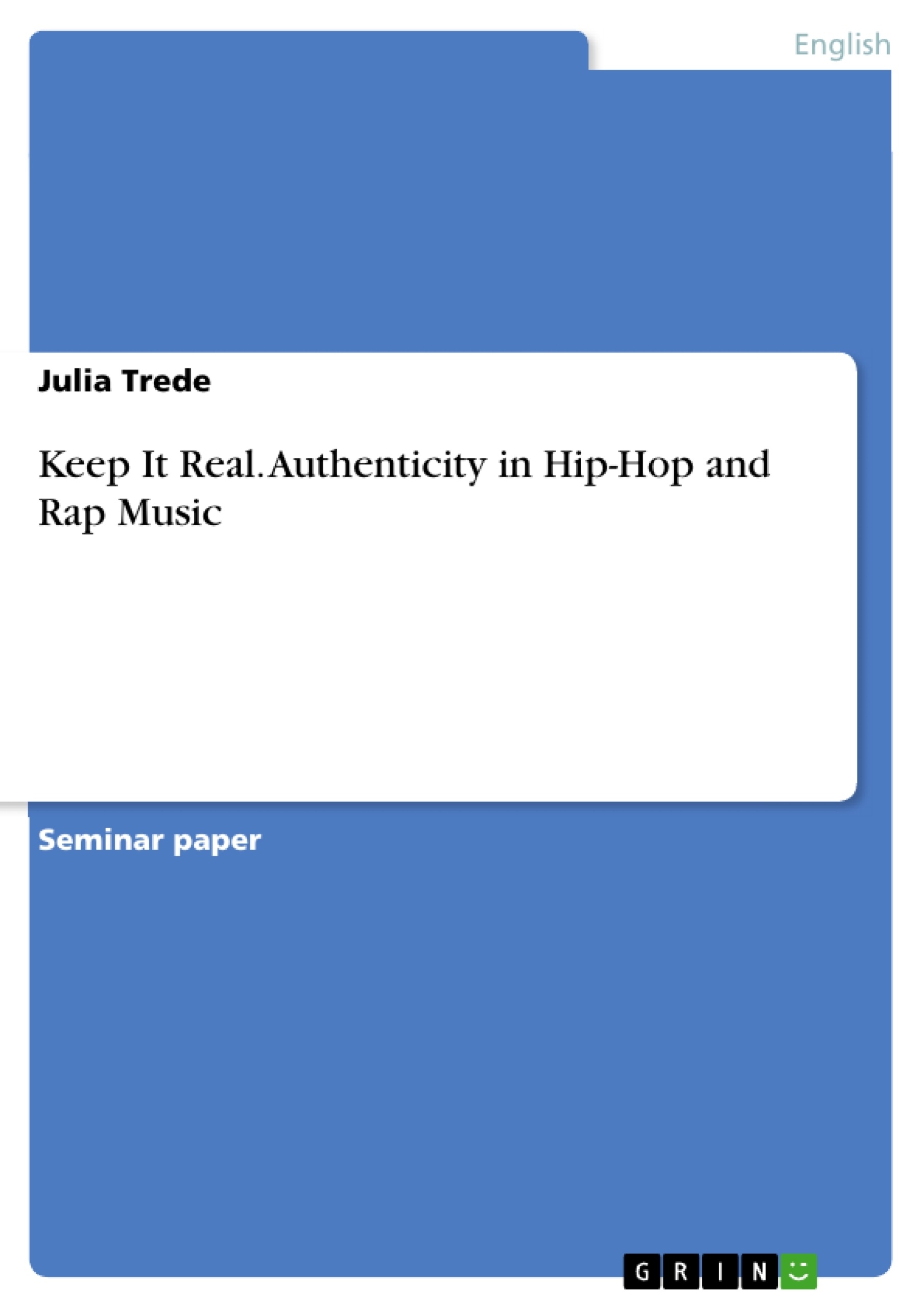Hip-hop does only represent a mere music genre but also constitutes a movement that emerged out of profound economic and social changes in New York of the 1970s. It is a cultural expression of an Afrodiasporic community that faced social and racial inequity. Originally, hip-hop constituted a shelter for ethnic minorities that have been socially marginalized by the dominant American culture. However, hip-hop also constitutes a commercial commodity which is often reduced to its commercial purpose. This balancing act of representing a culture on the one hand, and a commodity on the other hand, evoked a discussion on authenticity.
The aim of this paper is to analyze how and to what extent authenticity is claimed in songs of hip-hop artists. In order to understand the discussion of authenticity in hip-hop it is crucial to provide an informational background of the preconditions that contributed to the development of hip-hop. Chapter 1.1 provides this basis and describes social and political circumstances that America and especially New York experienced throughout the 1970s. The resulting evolution of the hip-hop movement is subject to chapter 1.2., explaining the beginnings of the movement and outlining hip-hop’s elements. Chapter 2 is concerned with the concept of authenticity. In the course of this section I will deal with Kembrew McLeod’s six semantic dimensions of authenticity which serve as a basis for the subsequent analyses. The last chapter provides an analysis of five rap songs that will be analyzed according to McLeod’s dimensions of authenticity. The aim of this chapter is to find out, to what extent authenticity claims are used and how many dimensions can be identified in a song. Additionally, it is analyzed, if certain dimensions a used more frequently, or more specifically, if it is possible to allocate priorities to McLeod’s dimensions.
Inhaltsverzeichnis (Table of Contents)
- Introduction
- Historical Background
- Preconditions
- The Evolution of Hip-Hop
- Dimensions of Authenticity after McLeod
- Social-psychological Dimension
- Racial Dimension
- Political-economic Dimension
- Gender-sexual Dimension
- Social-locational Dimension
- Cultural Dimension
- Analyses
- N.W.A Straight Outta Compton
- N.W.A- Fuck Tha Police
- N.W.A – Express Yourself
- Ice Cube When Will They Shoot?
- Jay Z - Moment of Clarity
- Conclusion
Zielsetzung und Themenschwerpunkte (Objectives and Key Themes)
The paper aims to analyze how and to what extent authenticity is claimed in songs of hip-hop artists. This research seeks to understand the discussion of authenticity in hip-hop by exploring the preconditions that contributed to its development. The paper will examine the six semantic dimensions of authenticity proposed by Kembrew McLeod, using them as a framework for analyzing five rap songs.
- The development of hip-hop as a cultural expression of an Afrodiasporic community facing social and racial inequity.
- The concept of authenticity in hip-hop and its various dimensions.
- Analysis of rap songs through the lens of McLeod's six dimensions of authenticity.
- The role of authenticity claims in hip-hop music.
- The relationship between hip-hop as a cultural movement and its commercialization.
Zusammenfassung der Kapitel (Chapter Summaries)
The introduction provides an overview of hip-hop as a cultural movement that emerged from social and economic changes in New York during the 1970s. It highlights the balancing act between representing a culture and being a commercial commodity, which fuels the discussion on authenticity. Chapter 1.1 delves into the historical context of hip-hop's development, focusing on political, economic, and social conditions in the United States, particularly in New York, during the 1960s and 1970s. The chapter highlights the economic restructuring of urban America and its impact on ethnic minorities, emphasizing the housing crisis and the widening gap between classes and races. Chapter 1.2 explores the evolution of hip-hop and its significance as an outlet for expression and identification for young African Americans. This chapter also outlines the four elements of hip-hop and the importance of self-definition and identity formation. Chapter 2 delves into the concept of authenticity, exploring Kembrew McLeod's six semantic dimensions. These dimensions serve as the framework for the subsequent analysis of rap songs.
Schlüsselwörter (Keywords)
The primary focus of this work lies on the concept of authenticity in hip-hop music. Key terms include authenticity, hip-hop, rap music, Afrodiasporic culture, social and racial inequity, commercialization, Kembrew McLeod's six dimensions of authenticity, cultural expression, identity formation, and the historical and socio-economic context of hip-hop's emergence.
- Quote paper
- Julia Trede (Author), 2013, Keep It Real. Authenticity in Hip-Hop and Rap Music, Munich, GRIN Verlag, https://www.grin.com/document/511357



